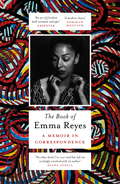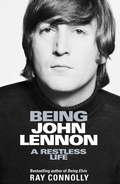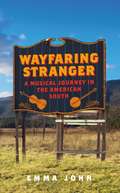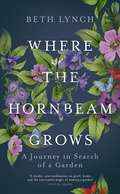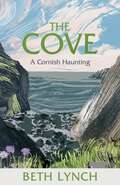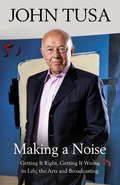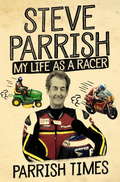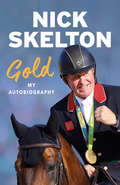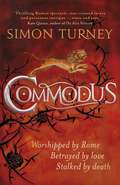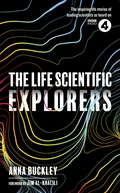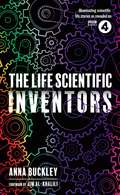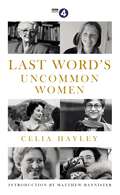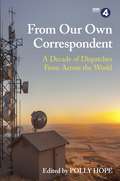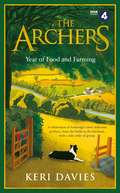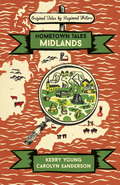- Table View
- List View
The Book of Emma Reyes: A Memoir in Correspondence
by Emma ReyesThis astonishing memoir of a childhood lived in extreme poverty in Latin America was hailed as an instant classic when first published in Colombia in 2012, nine years after the death of its author, who was encouraged in her writing by Gabriel García Márquez. Comprised of letters written over the course of thirty years, it describes in vivid, painterly detail the remarkable courage and limitless imagination of a young girl growing up with nothing. Emma was an illegitimate child, raised in a windowless room in Bogotá with no water or toilet and only ingenuity to keep her and her sister alive. Abandoned by their mother, she and her sister moved to a convent housing 150 orphan girls, where they washed pots, ironed and mended laundry, scrubbed floors, cleaned bathrooms, and sewed garments and decorative cloths for church. Illiterate and knowing nothing of the outside world, Emma escaped at age nineteen, eventually coming to have a career as an artist and to befriend the likes of Frida Kahlo and Diego Rivera. Far from self-pitying, the portrait that emerges from this clear-eyed account inspires awe at the stunning early life of a gifted writer whose talent remained hidden for far too long.
Being John Lennon
by Ray ConnollyJohn Lennon was a rock star, a school clown, a writer, a wit, an iconoclast, a sometime peace activist and finally an eccentric millionaire. He was also a Beatle - his plain-speaking and impudent rejection of authority catching, and eloquently articulating, the group's moment in history.Chronicling a famously troubled life, Being John Lennon analyses the contradictions in the singer-songwriter's creative and destructive personality. Drawing on many interviews and conversations with Lennon, his first wife Cynthia and second Yoko Ono, as well as his girlfriend May Pang and song-writing partner Paul McCartney, Ray Connolly unsparingly reassesses the chameleon nature of the perpetually dissatisfied star who just couldn't stop reinventing himself.
Being John Lennon: A Restless Life
by Ray ConnollyJohn Lennon was a rock star, a school clown, a writer, a wit, an iconoclast, a sometime peace activist and finally an eccentric millionaire. He was also a Beatle - his plain-speaking and impudent rejection of authority catching, and eloquently articulating, the group's moment in history.Chronicling a famously troubled life, Being John Lennon analyses the contradictions in the singer-songwriter's creative and destructive personality. Drawing on many interviews and conversations with Lennon, his first wife Cynthia and second Yoko Ono, as well as his girlfriend May Pang and song-writing partner Paul McCartney, Ray Connolly unsparingly reassesses the chameleon nature of the perpetually dissatisfied star who just couldn't stop reinventing himself.
Wayfaring Stranger: A Musical Journey in the American South
by Emma JohnCan you feel nostalgic for a life you've never known?Suffused with her much-loved warmth and wit, Emma John's memoir follows her moving and memorable journey to master one of the hardest musical styles on earth - and to find her place in an alien world.Emma had fallen out of love with her violin when a chance trip to the American South introduced her to bluegrass music. Classically trained, highly strung and wedded to London life, Emma was about as country as a gin martini. So why did it feel like a homecoming?Answering that question takes Emma deep into the Appalachian mountains, where she uncovers a hidden culture that confounds every expectation - and learns some emotional truths of her own.
Wayfaring Stranger: A Musical Journey in the American South
by Emma JohnCan you feel nostalgic for a life you've never known?Suffused with her much-loved warmth and wit, Emma John's memoir follows her moving and memorable journey to master one of the hardest musical styles on earth - and to find her place in an alien world.Emma had fallen out of love with her violin when a chance trip to the American South introduced her to bluegrass music. Classically trained, highly strung and wedded to London life, Emma was about as country as a gin martini. So why did it feel like a homecoming?Answering that question takes Emma deep into the Appalachian mountains, where she uncovers a hidden culture that confounds every expectation - and learns some emotional truths of her own.
Where the Hornbeam Grows: A Journey in Search of a Garden
by Beth Lynch'Beth Lynch's subtle and moving book is about the heart-work of finding and making a place for oneself in the world; the effort of putting down roots, the pain of tearing them up again, and how one grows to know another person or another landscape. Horticulture and human feelings twine together here - and what flourishes in the several gardens of this book is, in the end, hope' ROBERT MACFARLANE'I loved Beth Lynch's tender, wise meditation on grief, home, and the restorative magic of making a garden' OLIVIA LAINGOut of place and lonely after a relocation to Switzerland, Beth Lynch realises that she needs to get her hands dirty if she is to put down roots. And so she sets about making herself at home in the way she knows best - by tending a garden, growing things. The search for a garden takes her across the country, through meadows and on mountain paths where familiar garden plants run wild, to the rugged hills of the Swiss Jura where she begins to plant her paradise. WHERE THE HORNBEAM GROWS is a memoir about carrying a garden inwardly through loss, dislocation and relocation, about finding a sense of wellbeing in a green place of one's own, and about the limits of paradise in a peopled world. It is a powerful exploration of how, in nurturing a corner of the natural world, we ourselves are nurtured.
The Cove: A Cornish Haunting
by Beth LynchFor over five decades Beth Lynch has been drawn back, over and again, to a rocky spot on the North Cornwall coast. Her earliest memories of the cove are bound up with idyllic family holidays; as she grows older, however, her sense of connection with the place grows deeper and more complicated. This slippery interface of land and sea - a site of sheer edges and ledges, peculiar rock formations and eroding, tumbling slate - becomes her childhood refuge from anxiety and school bullying.Around the time of her parents' deaths, strange things start to happen in and around the cove, and Lynch is left wondering how well she really knows this minute section of coast that draws her so ineluctably. Is it the cove, or is it her? What secrets does the cove have to share? Is she safer staying away? Unfolding through a medium of salt and slate, the elemental indifference of Atlantic Cornwall, The Cove is a lyrical meditation on being a revenant, on haunting and being haunted. Through encounters with quarrymen, wartime women and a enigmatic archaeologist - along with JMW Turner, Alfred, Lord Tennyson, Anthony Trollope, and Thomas and Emma Hardy - Lynch contemplates what happens when our deepest fears materialise, reflecting on mortality and the nuanced ways in which we take leave of our dead. She explores the profound impacts of change - in ourselves, in places and in the transformative dance between the two.
Making a Noise: Getting It Right, Getting It Wrong in Life, Arts and Broadcasting
by Sir John TusaJohn Tusa is a distinguished journalist, broadcaster and leader of arts organisations, best remembered for his times at the BBC, including creating Newsnight.Tusa's memoir is etched with candour. His account of two years of internecine warfare at the top of the BBC under the Chairman, 'Dukey' Hussey will go down as a major contribution to BBC history. His recollections of a hilarious and petty-minded few months as head of a Cambridge college will be read as a case study of the absurdities of academic life; while running the rejected and maligned Barbican Centre, Tusa led its recovery into the major cultural centre that it is today.
Making a Noise: Getting It Right, Getting It Wrong In Life, Arts And Broadcasting
by John TusaIn almost sixty years of professional life, John Tusa has fought for and sometimes against the major arts and political institutions in the country. A distinguished journalist, broadcaster and leader of arts organisations, he has stood up publicly for the independence of the BBC, the need for public funding of the arts and for the integrity of universities. He has made enemies in the process. From the battles to create the ground-breaking Newsnight in 1979, to six years of defending the BBC World Service from political interference, Tusa's account is etched with candour. His account of two years of internecine warfare at the top of the BBC under the Chairman, 'Dukey' Hussey will go down as a major contribution to BBC history. His recollections of a hilarious and petty-minded few months as head of a Cambridge college will be read as a case study of the absurdities of academic life; while running the rejected and maligned Barbican Centre, Tusa led its recovery into the major cultural centre that it is today.Often based on personal diaries, Making a Noise is a fearless and entertaining memoir of life at the top of the arts and broadcasting.
Parrish Times: My Life as a Racer
by Steve ParrishChampion motorcyclist and truck racer, television presenter, practical joker or just plain survivor - Steve Parrish has been called them all. Parrish Times tracks his amazing journey over the last four decades, through a rollercoaster ride of emotions in surely the most dangerous and exhilarating sporting arena there is.In the 1970s Steve was competing for the world motorcycle championship with legendary team mate Barry Sheene on a Suzuki. After retiring in 1986, Steve managed a successful Yamaha factory team to three British Superbike Championship titles and started a truck-racing career, becoming the most successful truck racer ever. He also proved to be a natural commentator, first for BBC radio, then transferring to television with Sky, ITV and Eurosport. Against this backdrop are Steve's notorious pranks: posing as a medical doctor to allow John Hopkins to fly from Japan to the Australian GP; impersonating Barry Sheene in a qualifying session; owning a fire engine, a hearse, and an ambulance - parking it on double yellow lines with the doors open in visits to his local bank.It's a funny, hell-raising account of life - and death - in the fast lane that will keep readers enthralled to the end. Barry Sheene's final words to his best friend sum it up: 'Neither of us will die wondering.'
Parrish Times: My Life as a Racer
by Steve ParrishChampion motorcyclist and truck racer, television presenter, practical joker or just plain survivor - Steve Parrish has been called them all. Parrish Times tracks his amazing journey over the last four decades, through a rollercoaster ride of emotions in surely the most dangerous and exhilarating sporting arena there is.In the 1970s Steve was competing for the world motorcycle championship with legendary team mate Barry Sheene on a Suzuki. After retiring in 1986, Steve managed a successful Yamaha factory team to three British Superbike Championship titles and started a truck-racing career, becoming the most successful truck racer ever. He also proved to be a natural commentator, first for BBC radio, then transferring to television with Sky, ITV and Eurosport. Against this backdrop are Steve's notorious pranks: posing as a medical doctor to allow John Hopkins to fly from Japan to the Australian GP; impersonating Barry Sheene in a qualifying session; owning a fire engine, a hearse, and an ambulance - parking it on double yellow lines with the doors open in visits to his local bank.
Gold: My Autobiography
by Nick SkeltonWith a show-jumping career spanning over forty years, Nick Skelton is a legend in the equestrian world. No other rider has won so many major competitions on so many different horses and he is as popular at Olympia and Hickstead as he is at Aachen, Geneva, Paris and Spruce Meadows. Skelton has competed in eight Olympic Games. He was part of the gold medal-winning Great Britain team at London 2012 and made history by winning the individual Olympic gold medal at Rio 2016, riding at the age of fifty-eight his beloved horse Big Star.Nick Skelton began riding at the age of eighteen months on a Welsh pony called Oxo. At the age of seventeenth in 1975, Skelton took team silver and individual gold at the Junior European Championships. He has competed many times at the European Show Jumping Championships, winning numerous medals, both individually and with the British team. In 1980 he competed in the Alternative Olympics, where he helped the British team to a silver medal. He still holds the British Show Jumping High Jump record that he set in 1978.In 2000, Skelton was forced into an early retirement after he broke his neck from a serious fall. But following an amazing recovery he came out of retirement in 2002 to compete again. Now he tells the full story of his eventful life and matchless achievements.
Commodus: The Damned Emperors Book 2 (The Damned Emperors)
by Simon TurneyWorshipped by Rome. Betrayed by love. Stalked by death. Rome is enjoying a period of stability and prosperity. The Empire's borders are growing, and there are two sons in the imperial succession for the first time in Rome's history. But all is not as it appears. Cracks are beginning to show. Two decades of war have taken their toll, and there are whispers of a sickness in the East. The Empire stands on the brink of true disaster, an age of gold giving way to one of iron and rust, a time of reason and strength sliding into hunger and pain.The decline may yet be halted, though. One man tries to hold the fracturing empire together. To Rome, he is their emperor, their Hercules, their Commodus.But Commodus is breaking up himself, and when the darkness grips, only one woman can hold him together. To Rome she was nothing. The plaything of the emperor. To Commodus, she was everything. She was Marcia.
Commodus: The Damned Emperors Book 2 (The\damned Emperors Ser.)
by Simon TurneyRome is enjoying a period of stability and prosperity. The Empire's borders are growing, and there are two sons in the imperial succession for the first time in Rome's history. But all is not as it appears. Cracks are beginning to show. Two decades of war have taken their toll, and there are whispers of a sickness in the East. The Empire stands on the brink of true disaster, an age of gold giving way to one of iron and rust, a time of reason and strength sliding into hunger and pain.The decline may yet be halted, though. One man tries to hold the fracturing empire together. To Rome, he is their emperor, their Hercules, their Commodus.But Commodus is breaking up himself, and when the darkness grips, only one woman can hold him together. To Rome she was nothing. The plaything of the emperor. To Commodus, she was everything. She was Marcia.
The Life Scientific: Virus Hunters
by Anna BuckleyBBC Radio 4's celebrated THE LIFE SCIENTIFIC has featured some of the world's most renowned experts in the field of deadly viruses. The interviews make sobering reading, a reminder of all the deadly viruses that have threatened global health, and why for the scientists working on the front line in the war against viruses, the arrival of Covid-19 came as no surprise. Among the contributors to this all-too-timely book are:Jeremy Farrar, before he became Director of the Wellcome Trust, worked in an Infectious Diseases Hospital in Vietnam. He was on the frontline tackling SARS and nine months later a highly pathogenic strain of bird flu, H5N1. Peter Piot was at the forefront of the Ebola epidemic in West Africa. He was the first to identify HIV in Africa. It took him fifteen years to persuade the world that it was also a heterosexual disease. Later as Executive Director of UN AIDS he fought for years to get the UN to take the threat of HIV seriously.Jonathan Ball studies how viruses operate at the molecular level, hoping to find their Achilles' heel and so develop effective vaccines. During the West Africa Ebola epidemic, he studied how the genome of the Ebola virus evolved as it spread from Guinea to Liberia and Sierra Leone. He has shown that as this virus (which more happily lives in bats) infects more humans, it becomes ever more infectious.Wendy Barclay seeks to understand how viruses are able to jump from animals to humans and why some viruses are so much more dangerous to humans than others. Most Londoners had no idea they were infected during the Swine Flu pandemic of 2009. The Bird Flu epidemic in Asia claimed thousands of livesKate Jones is a bat specialist who works on how ecological changes and human behaviour accelerate the spread of animal viruses into humans. Bats have been infected with coronaviruses for more than 10,000 years.
The Life Scientific: Explorers
by Anna BuckleyInspiring life stories from BBC Radio 4's hit series The Life Scientific'In showing non-scientists why science offers so many paths to discovery it has no equal' Gillian Reynolds, TelegraphBased on Jim Al-Khalili's ground-breaking interviews, The Life Scientific: Explorers takes science out of its box and introduces us to the men and women who make it happen.The explorers featured in this volume include: Michele Dougherty, the mathematician who persuaded the Cassini mission to Saturn to make a diversion; Richard Fortey on his love of trilobites; Monica Grady, Meteorite Lady; neurosurgeon Henry Marsh on slicing through our thoughts; the Director of the British Antarctic Survey, Jane Francis; Jocelyn Bell Burnell describing how she missed out on a Nobel Prize; Brian Cox on quantum mechanics; and Nobel Prize winner John Sulston on why he thought it would be a good idea to sequence the human genome.
The Life Scientific: Explorers
by Anna BuckleyInspiring life stories from BBC Radio 4's hit series The Life Scientific'In showing non-scientists why science offers so many paths to discovery it has no equal' Gillian Reynolds, TelegraphBased on Jim Al-Khalili's ground-breaking interviews, The Life Scientific: Explorers takes science out of its box and introduces us to the men and women who make it happen.The explorers featured in this volume include: Michele Dougherty, the mathematician who persuaded the Cassini mission to Saturn to make a diversion; Richard Fortey on his love of trilobites; Monica Grady, Meteorite Lady; neurosurgeon Henry Marsh on slicing through our thoughts; the Director of the British Antarctic Survey, Jane Francis; Jocelyn Bell Burnell describing how she missed out on a Nobel Prize; Brian Cox on quantum mechanics; and Nobel Prize winner John Sulston on why he thought it would be a good idea to sequence the human genome.
The Life Scientific: Inventors
by Anna BuckleyWhat does it take to be an inventor? Judging by the ingenious individuals who have come into The Life Scientific studio in the last eight years, there is no simple answer. Mathematicians, electricians, molecular biologists and mechanics can all transform lives. Some think with their hands, others make things in their minds. Most have a vision of the future. All are driven by a passionate determination to solve problems.These intimate accounts, based on interviews recorded for the popular BBC Radio 4 programme The Life Scientific, chart the life journeys of scientists and engineers working in Britain today from childhood interests to innovation. Explaining what they did when and why, they make science seem straightforward and exciting, revealing moments of disappointment, creativity, frustration and joy. The result is an illuminating collection of biographical short stories that make scientists and the work they do accessible to us all.
The Life Scientific: Inventors
by Anna BuckleyWhat does it take to be an inventor?Judging by the ingenious individuals who have come into The Life Scientific studio in the last eight years, there is no simple answer. Mathematicians, electricians, molecular biologists and mechanics can all transform lives. Some think with their hands, others make things in their minds. Most have a vision of the future. All are driven by a passionate determination to solve problems.These intimate accounts, based on interviews recorded for the popular BBC Radio 4 programme The Life Scientific, chart the life journeys of scientists and engineers working in Britain today from childhood interests to innovation. Explaining what they did when and why, they make science seem straightforward and exciting, revealing moments of disappointment, creativity, frustration and joy. The result is an illuminating collection of biographical short stories that make scientists and the work they do accessible to us all.
Last Word's Uncommon Women
by Celia HayleyLast Word is the popular BBC Radio 4 series broadcast weekly, featuring the lives of several famous people who have recently died. More than standard obituaries, the lives are summarised with narration and include interviews with some of those who knew them. The programme was first broadcast in 2006 and this compelling anthology commemorates the remarkable and revealing lives of 80 women who were illuminating, inspiring or moving. Their names may not always be well known, but their lives made an impact on the world, and they broke new ground in many different ways. The book includes: Lt Islam Bibi - Helmand's top female police officer, shot dead by the Taliban Naty Revuelta Clews - Fidel Castro's mistress Naomi Sims - first Black supermodel Sylvia Robinson - The 'mother of hip-hop' who was the founder/CEO of Sugar Hill records Rosalia Mera - Zara founder, the world's richest self-made woman Marie Colvin - celebrated war reporter killed in Homs Clare Hollingworth - first war correspondent to report the outbreak of the Second World War Eileen Nearne - wartime spy who was captured and tortured by the Gestapo Salome Karwah - Ebola survivor who went back to Liberia to nurse other sufferers Jo Cox - MP murdered in her own Yorkshire constituency Jill Saward - rape survivor and campaigner for victims of sexual abuse Scharlette Holdman - 'The Angel of Death Row' who fought against the death penalty in the US Jeanne Cordova - former nun who became a lesbian rights activist Francis Kelsey - pharmacologist who prevented the licence of Thalidomide in the US Margaret Rule - archaeologist who raised the Mary Rose Countess of Arran - powerboat racer, 'the fastest granny on water'
Last Word's Uncommon Women
by Celia HayleyLast Word is the popular BBC Radio 4 series broadcast weekly, featuring the lives of several famous people who have recently died. More than standard obituaries, the lives are summarised with narration and include interviews with some of those who knew them. The programme was first broadcast in 2006 and this compelling anthology commemorates the remarkable and revealing lives of 80 women who were illuminating, inspiring or moving. Their names may not always be well known, but their lives made an impact on the world, and they broke new ground in many different ways. The book includes: Lt Islam Bibi - Helmand's top female police officer, shot dead by the Taliban Naty Revuelta Clews - Fidel Castro's mistress Naomi Sims - first Black supermodel Sylvia Robinson - The 'mother of hip-hop' who was the founder/CEO of Sugar Hill records Rosalia Mera - Zara founder, the world's richest self-made woman Marie Colvin - celebrated war reporter killed in Homs Clare Hollingworth - first war correspondent to report the outbreak of the Second World War Eileen Nearne - wartime spy who was captured and tortured by the Gestapo Salome Karwah - Ebola survivor who went back to Liberia to nurse other sufferers Jo Cox - MP murdered in her own Yorkshire constituency Jill Saward - rape survivor and campaigner for victims of sexual abuse Scharlette Holdman - 'The Angel of Death Row' who fought against the death penalty in the US Jeanne Cordova - former nun who became a lesbian rights activist Francis Kelsey - pharmacologist who prevented the licence of Thalidomide in the US Margaret Rule - archaeologist who raised the Mary Rose Countess of Arran - powerboat racer, 'the fastest granny on water'
From Our Own Correspondent: Dispatches of a Decade from Across the World
by Polly Hope<p>For more than sixty-five years on the air, From Our Own Correspondent has been one of BBC Radio's flagship programmes. It has taken listeners to parts of the world where they have never gone, and perhaps never would: war zones, refugee camps, elite universities, space stations, spy academies and lions' dens of all sorts. Its dispatches introduce audiences to people they might never expect to meet - kingpins, revolutionaries, assassins and outcasts. It has always relied on the power of personal testimony, with its contributors not merely reporting the news, but sharing what they found out along the way, and how it felt. Its correspondents often relate the unexpected: the day they visited the town that is crazy about trout fishing, attended a forty-course Chinese banquet, experienced zero gravity on a flight with Russian cosmonauts, went mud wrestling in Turkey or ballroom dancing in Cameroon.<p> <p>Themed by continent and region, From Our Own Correspondent brings together the most compelling stories of the past ten years. It is a perfect primer for the understanding of the modern world.<p>
The Archers Year Of Food and Farming: A celebration of Ambridge's most delicious produce, from the fields to the kitchens, with a side order of gossip
by Keri Davies'What's for tea, Clarrielove?' From the fabled kitchens of Ambridge come the recipes and gossip that fuel the nation's favourite village.Whether it's Susan's spicy chilli con carne on the hob or Helen's dramatic tuna bake in the oven, Jill's flapjacks stacked high or Alastair's Goan fish curry hotting up suppertime, this celebration of Ambridge life will take fans even closer to the heart of every Archers home.But this book isn't just a cook-along with our favourite families. It's full to the brim with tales and memories. The Archers Year of Food and Farming shares the ups and downs of the inhabitants of Ambridge and celebrates our countryside in all of its green and pleasant glory.Month-by-month, we learn more about the farming community and those big events in the Ambridge calendar: Shrove Tuesday and Easter, lambing, Open Farm Sunday, the village fete, Apple Day, the harvest, Stir-up Sunday and Deck the Hall.Rural traditions are alive and well in The Archers, but it's a contemporary world that is full of warmth, wit and the unexpected.
The Archers Year Of Food and Farming: A celebration of Ambridges most delicious produce, from the fields to the kitchens, with a side order of gossip
by Keri Davies'What's for tea, Clarrielove?' From the fabled kitchens of Ambridge come the recipes and gossip that fuel the nation's favourite village.Whether it's Susan's spicy chilli con carne on the hob or Helen's dramatic tuna bake in the oven, Jill's flapjacks stacked high or Alastair's Goan fish curry hotting up suppertime, this celebration of Ambridge life will take fans even closer to the heart of every Archers home.But this book isn't just a cook-along with our favourite families. It's full to the brim with tales and memories. The Archers Year of Food and Farming shares the ups and downs of the inhabitants of Ambridge and celebrates our countryside in all of its green and pleasant glory.Month-by-month, we learn more about the farming community and those big events in the Ambridge calendar: Shrove Tuesday and Easter, lambing, Open Farm Sunday, the village fete, Apple Day, the harvest, Stir-up Sunday and Deck the Hall.Rural traditions are alive and well in The Archers, but it's a contemporary world that is full of warmth, wit and the unexpected.
Hometown Tales: Midlands (Hometown Tales Ser.)
by Kerry Young Carolyn SandersonOriginal tales by remarkable writersHometown Tales is a series of books pairing exciting new voices with some of the most talented and important writers at work today. Some of the tales are fiction and some are narrative non-fiction - they are all powerful, fascinating and moving, and aim to celebrate regional diversity and explore the meaning of home.In these pages on the Midlands, you'll find two unique works of fiction. A richly-imagined tale about a young girl adopted by a couple living in the village of Fleckney - 'Home Is Where the Heart Is' - by author of Costa-shortlisted Pau, Kerry Young. And 'Time and Seasons', a heartfelt, powerful story of young love across the ages in Milton Keynes by Carolyn Sanderson.
